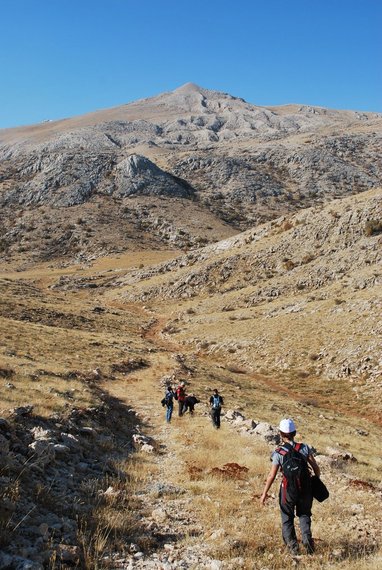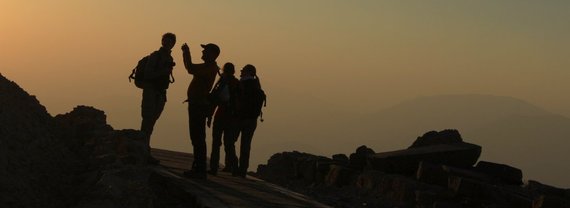At the summit of Mt. Nemrut, a king has surrounded himself with the gods. These are our last two days of exploring new stages of the Abraham Path in southeastern Turkey.
The climb up makes me realize it should have been the start of our trip rather than its end. This is by far the most spectacular walk of our weeklong journey. Lead by guides Omer and Haji, we are perhaps the first visitors to explore the eastern ascent on foot. For some in our group it also the toughest stage, the grand finale of roughing it for a week in a region that is pretty much devoid of Western travel deluxe.
At 2,150 meters (just over 7,000 feet), Mt. Nemrut's summit is only a lower to medium range peak to climb in Turkey, whose mountains in the far east reach as high as 5,000 meters. But no mountain has a story like this one. After a slow start to the day, a brisk climb leads us across narrow shepherd trails and scrambling over sharply jagged rocks that ring the summit as a barrier of natural barbed wire. All guidebooks mention Mt. Nemrut but none is helpful on how to ascent it on foot. Fortunately, our guide Haji climbs as if it was his own backyard. I also carry a map ably pre-scouted through Google Earth by Julian Bender, one of Abraham Path's trail experts. We can see the sharp peak for most of our ascent. It appears deceivingly close at the start, but as we progress our legs tell us otherwise. Haji (pictured) is the oldest of our group and probably the fittest; he seems to enjoy moving up and down between the front and back end of our group. For the rest of us, the summit is not for free.
But what is the summit, exactly? The natural peak of Nemrut has remained covered for more than two millennia and the pyramid that sits on top of the mountain consists of hundreds of thousands of small stones, the debris of the larger than life godly statues at its foot. This is, allegedly, the last resting place of King Antiochus I, who ruled over this region 70-38 BC. From high up the gods still watch over its fate, greeting the sunrise and sunset each day. In the last hour of our climb, we step up the pace to make sure we do not miss the spectacle of the gods bidding farewell to the day.

Apart from meeting the giant statues and the pyramid, the objective of our venture today is to test a possible extension of the Abraham Path into these mountains. The trail presently starts in Yuvacali, situated in soft gentle hills some 50 kilometers north of one of the birth cities of Abraham, Urfa. It was there that, according to the local Muslim tradition, Abraham was born and where he challenged a king by the name of Nemrut and his worship of idols. The mountain we climb up is named after that king, the nemesis in Abraham's early life. Though Antiochus only enters the story two millennia later he chooses this mountain top at the end of his life, not only as his last resting place, but more prominently as a symbol of his companionship and peer stature to Greek and Roman gods.
Beyond his own depiction amidst Zeus, Apollo, and Hercules, there are giant stone slabs depicting Mars, Venus and Mercury. Antiochus himself takes center stage, allegedly being buried somewhere underneath the 50-meter tall pyramid of small stones. It is a place inaccessible to man as any excavation would destroy the structure. Apparently not all visitors understand this: multiple signs read "Do Not Climb!" The pyramid style grave -- a burial mound called a tumulus -- is an unverifiable story of burial but regardless of the presence of a megalomaniac king underneath, its iconic shape stands out from the mild, rounded and natural summits of the sister peaks in the area.
Far below us flow the tributaries to the Euphrates, a river central to the story of Abraham. We cross it by ferry the next day. It has been a rewarding journey with a true grand finale. Mt. Nemrut in all senses is the other half of the Abraham Path. It is topographically the half that was missing until this week: a true mountain stage for fit and adventurous walkers, and a natural balcony overlooking the more gentle stages on the other side of the Euphrates. And until we explore northern Iraq, a journey planned for the fall of 2014, this will certainly be the path's highest point to date.
But thematically also, it is the other half of the story: all that Abraham revolted against. Mt. Nemrut represents the deeply fascinating heritage of an old world before the dominance of monotheism. It will be approximately six days walking to connect Mt. Nemrut back to Yuvacali, the village where we started last week. That route will include a spectacular descent towards and crossing over the Euphrates. Yet another journey to look forward to.
Photography by David Landis, Lubna Ghneim, and Stefan Szepesi






